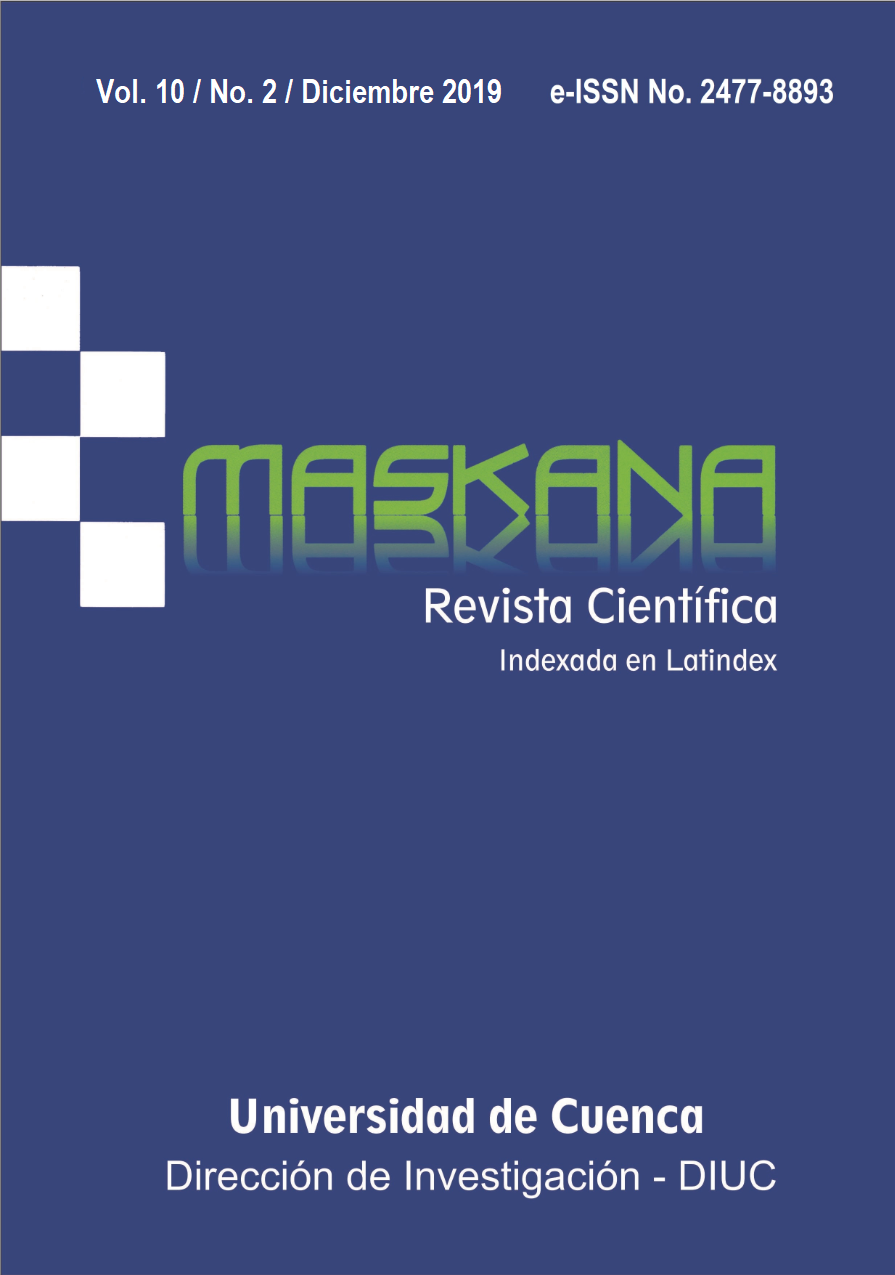Respuesta de semillas de tres especies nativas altoandinas a diferentes condiciones de almacenamiento
DOI:
https://doi.org/10.18537/mskn.10.02.07Palabras clave:
Tiempo de almacenamiento, contenido de humedad, temperatura, Parque Nacional El Cajas, AndesResumen
Para asegurar la capacidad de germinación y viabilidad de especies forestales nativas es importante conocer las condiciones óptimas para el almacenamiento de semillas a largo plazo. En respuesta a esto, nosotros investigamos el efecto del almacenamiento de semillas en la germinación, viabilidad y velocidad de germinación (VG) de Vallea stipularis, Hedyosmum luteynii y Oreopanax avicenniifolius. Las semillas fueron colectadas de los bosques Llaviucu y Mazán del Parque Nacional El Cajas y fueron expuestas a diferentes tratamientos de almacenamiento: tres contenidos de humedad (inicial, medio bajo), dos temperaturas (10°C y temperatura ambiente) y tres tiempos de almacenamiento (3, 6 y 12 meses). Los resultados mostraron que en general las semillas de V. stipularis almacenadas a 10ºC durante 12 meses, presentaron bajos e incluso nulos porcentajes de geminación; la viabilidad y VG disminuía conforme se incrementaba el tiempo de almacenamiento. Las semillas de H. luteynii tuvieron una alta germinación y viabilidad hasta los 12 meses de almacenamiento a 10ºC, sin embargo, su germinación fue tardía y poco sincronizada. El almacenamiento a temperatura ambiente no favoreció la germinación y VG de las dos especies, aunque, H. luteynii mantuvo su viabilidad intacta hasta el último periodo evaluado. O. avicenniifolius mantuvo su capacidad germinativa hasta los 12 meses de almacenamiento, tanto a 10ºC como temperatura ambiente, pero con baja germinación. El conocimiento generado contribuye para un mejor manejo de las semillas, en programas de conservación ex situ y la producción de plántulas para la restauración.
Descargas
Métricas
Citas
Ali, S., Bouinot, D., Wagner, M. H., Bonnet, M., Sotta, B., Grappin, P., & Jullien, M. (2004). Changes in endogenous abscisic acid levels during dormancy release and maintenance of mature seeds: Studies with the Cape Verde Islands ecotype, the dormant model of Arabidopsis thaliana. Planta, 219(3), 479-488. https://doi.org/10.1007/s00425-004-1251-4
Bailly, C. (2004). Active oxygen species and antioxidants in seed biology. Seed Science Research, 14(2), 93-107. https://doi.org/10.1079/ssr2004159
Baskin, C. C., & Baskin, J. M. (2001). Seeds: ecology, biogeography, and evolution of dormancy and germination. San Diego, USA: Academic Press.
Baskin, C. C., & Baskin, J. M. (2003). Seed germination and propagation of Xyris tennesseensis a federal endamgered wetland species. Wetlands (Vol. 23). doi:https://doi.org/10.1672/0277-5212(2003)023[0116:sgapox]2.0.co;2
Baskin, C. C., & Baskin, J. M. (2014). Variation in seed dormancy and germination within and between individuals and populations of a species. Seeds: Ecology, biogeography and evolution of dormancy and germination. https://doi.org/10.1016/B978-0-12-4166776.00008-1
Bates, D., Machler, M., Bolker, B., & Walker, S. (2015). Fitti VCFR4ZAng linear mixed-effects models using lme4. Journal of Statistical Software, 67, 1-48. http://dx.doi.org/10.18637/ jss.v067.i01
Bewley, J. D., Bradford, K. J., Hilhorst, H. W. M., & Nonogaki, H. (2013). Seeds: physiology of development, germination and dormancy. New York, USA: Springer.
Bourgeois, B., Lemay, M. A., Landry, T., Rochefort, L., & Poulin, M. (2019). Seed storage behaviour of eight peatland pool specialists: Implications for restoration. Aquatic Botany, 152, 59-63. https://doi.org/10.1016/j.aquabot.2018.09.008
Çakmak, T., Atici, O., Agar, G., & Sunar, S. (2010). Natural aging-related biochemical changes in alfalfa (Medicago sativa L.) seeds stored for 42 years. International Research Journal of Plant Science, 1(1), 001-006.
Ceballos, Á., & López, J. (2007). Conservación de la calidad de semillas forestales nativas. Almacenamiento. 58(4), 265-292.
Courtis, A. (2013). Germinación de semillas: Cátedra de fisiología vegetal carreras. Universidad Nacional del Nordeste, Argentina, 1-22. Disponible en https://docplayer.es/12165022-Catedra-de-fisiologia-vegetal.html
Defries, R. S., Rudel, T., Uriarte, M., & Hansen, M. (2010). Deforestation driven by urban population growth and agricultural trade in the twenty-first century. Nature Geoscience, 3(3), 178-181. https://doi.org/10.1038/ngeo756
Doria, J. (2010). Generalidades sobre las semillas: su producción, conservación y almacenamiento. AGRIS, 31(1), 74-85.
Estrella, J., Manosalvas, R., Mariaca, J., & Ribadeneira, M. (2005). Biodiversidad y recursos genéticos: Una guía para su uso y acceso en el Ecuador. Quito, Ecuador: EcoCiencia.
FAO. (2012). El estado de los recursos geneticos forestales en el mundo. Informe Nacional Ecuador. Quito. Disponible en http://www.fao.org/3/i3825e/i3825e20.pdf
FAO, FIDA, & PMA. (2014). El estado de la inseguridad alimentaria en el mundo 2014. Fortalecimiento de un entorno favorable para la seguridad alimentaria y la nutrición. Rome, Italy: FAO. Disponible en http://www.fao.org/3/a-i4030s.pdf
Gentil, D. F. de O. (2001). Conservao de sementes do cafeeiro: Resultados discordantes ou complementares? Bragantia, 60(3), 149-154.
Geneve, R. L. (2003). Impact of temperature on seed dormancy. HortScience: a publication of the American Society for Horticultural Science, 38(3), 336-341. doi:10.21273/HORTSCI.38.3.336
Grijalva, J., Ximena, C., Ramos, R., Barrera, P., Vera, R., & Sigcha, F. (2015). Estado de los recursos genéticos forestales en Ecuador. Programa Nacional de Forestería del Instituto Nacional de Investigaciones Agropecuarias. (Publicació). Retrieved from http://181.112.143.123/bitstream/41000/2827/1/iniapsc322est.pdf
ISTA. (2007). International rules for seed testing (Vol. 5). https://www.seedtest.org/en/home.html
Jimenez, J., Alche, J., Wang, W., & Rodríguez, M. (2007). Alpeorujo y semillas de olivo presentan el mismo tipo de proteinas de almacenamiento. En: Olivar, F. D. (Ed.), Simposium Científico Técnico del Año 2005, (págs. 365 - 376). doi:978-84-934503-0-4
Jiménez, J., & Patiño, C. (2019). Germinación, desarrollo inicial y supervivencia de plántulas bajo diferentes condiciones de almacenamiento de semillas de tres especies nativas de bosques del Parque Nacional Cajas (Universadad de Cuenca). Retrieved from http://dspace.ucuenca.edu.ec/handle/123456789/32802
Kindt, R., Lillesø, J.-P. B., Mbora, A., Muriuki, J., Wambugu, C., Frost, W., … Holding-Anyonge, C. (2006). Tree seeds for farmers: a toolkit and reference source. Nairobi, Kenya. Disponible en http://www.worldagroforestry.org/output/tree-seeds-farmers-toolkit-and-reference-source
Kucera, B., Cohn, M. A., & Leubner-Metzger, G. (2005). Plant hormone interactions during seed dormancy release and germination. Seed Science Research, 15(4), 281-307. https://doi.org/10.1079/SSR2005218
Kudred, K., & Sener, B. (1990). Effects of kinetin and gibberellic acid in overcoming high temperature and salinity (NaCl) stresses on the germination of barley and lettuce. Seeds Phyton (Horn, Austria), 30(1), 65-74.
Lengkeek, G., Jaenicke, H., & Dawson, K. (2005). Genetic bottlenecks in agroforestry systems: Results of tree nursery surveys in East Africa. Agroforestry Systems, 63(2), 149-155. https://doi.org/10.1007/s10457-004-9155-7
Ministerio del Ambiente. (2019). Plan Nacional de Restauración Forestal 2019-2030. Quito, Ecuador.
Myers, N., Mittermeier, R. A., Mittermeier, C. G., da Fonseca, G. A. B., & Kent, J. (2000). Biodiversity hotspots for conservation priorities. Nature, 403(6772), 853-858. https://doi.org/10.1038/35002501
Née, G., Xiang, Y., & Soppe, W. J. (2017). The release of dormancy, a wake-up call for seeds to germinate. Current Opinion in Plant Biology, 35, 8-14. https://doi.org/10.1016/j.pbi.2016.09.002
Palomeque, X., Maza, A., Iñamagua, J. P., Günter, S., Hildebrandte, P., Weber, M., Stimm, B. (2017). Variabilidad intraespecífica en la calidad de semillas de especies forestales nativas en bosques montanos en el sur del Ecuador: Implicaciones para la restauración de bosques. Revista de Ciencias Ambientales (Trop J Environ Sci), 51(2), 52-72.
Pakkad, G., Al Mazrooei, S., Blakesley, D., James, C., Elliott, S., Luoma-Aho, T., & Koskela, J. (2008). Genetic variation and gene flow among Prunus cerasoides D. Don populations in northern Thailand: Analysis of a rehabilitated site and adjacent intact forest. New Forests, 35(1), 33-43. https://doi.org/10.1007/s11056-007-9059-2
Pammenter, N. W., & Berjak, P. (2000). Semillas Ortodoxas y Recalcitrante. Obtenido de Manual de Semillas de Árboles Tropicales: https://rngr.net/publications/manual-de-semillas-de-arboles-tropicales/parte-i/semillas-ortodoxas_yrecalcitrantes/at_download/file
Pinheiro, J., Bates, D., DebRoy, S., & Sarkar, D. (2018). nlme: Linear and nonlinear mixed effects models. R package version 3.5.1. Obtenido de https://CRAN.R-project.org/package=nlme.
Pritchard, H. W., & Dickie, J. B. (2003). Predicting seed longevity: the use and abuse of seed viability equations. Chapter 35, 1-70. Disponible en https://www.academia.edu/17275313/ Predicting_seed_longevity_the_use_and_abuse_of_seed_viability_equations?auto=download
Pritchard, H. W. (2004). Classification of seed storage types for ex situ conservation in relation to temperature and moisture. Washington D.C., USA.
Procházková, Z., & Bezděčková, L. (2008). Effects of moisture content, storage temperature and type of storage bag on the germination and viability of stored European beech (Fagus sylvatica L.) seeds. Journal of Forest Science, 54(7), 287-293.
Pukacka, S., & Ratajczak, E. (2007). Age-related biochemical changes during storage of beech (Fagus sylvatica L.) seeds. Seed Science Research, 17(1), 45-53. https://doi.org/10.1017/S0960258507629432
Rajjou, L., Duval, M., Gallardo, K., Catusse, J., Bally, J., Job, C., & Job, D. (2012). Seed Germination and Vigor. Annual Review of Plant Biology, 63(1), 507-533. https://doi.org/10.1146/annurev-arplant-042811-105550
R Core Team. (2018). R: A language and environment for statistical computing. Disponible en https://www.R-project.org/
Ribeiro, J., & Costa, C. (2015). The effect of temperature regulation on seed germination of the tropical tree Myrsine parvifolia A. DC near its southern limit. South African Journal of Botany, 98, 128-133. https://doi.org/10.1016/j.sajb.2015.02.012
Romero-Saritama, J. M. (2018). Seed conservation: An alternative to store germplasm and recover threatened Ecuadorian forests. Neotropical Biology and Conservation, 13(1), 74-85. https://doi.org/10.4013/nbc.2018.131.09
Royal Botanic Gardens Kew. (2015). Seed Information Database(SID). Version 7.1. Disponible en http://data.kew.org/sid/
Schmidt, L. H. (2000). Guide to handling of tropical and subtropical forest seed. Danida Forest Seed Centre, Hoersholm, Denmark.
Shahidi, F., & Zhong, Y. (2010) Lipid oxidation and improving the oxidative stability. Chemical Society Reviews, 39, 4067-4079. http://dx.doi.org/10.1039/b922183m
Shu, K., Liu, X. D., Xie, Q., & He, Z. H. (2016). Two faces of one seed: Hormonal regulation of dormancy and germination. Molecular Plant, 9(1), 34-45. https://doi.org/10.1016/j.molp.2015.08.010
Siddique, A. B., & Wright, D. (2003). Effects of different seed drying methods on moisture percentage and seed quality (viability and vigour) of Pea Seeds (Pisum sativum L.). Asian Journal of Plant Sciences, 2(13), 978982. https://doi.org/10.3923/ja.2003.201.208
Sierra, R. (1999). Propuesta preliminar de un sistema de clasificación de vegetación para el Ecuador Continental [Preliminary proposal of a vegetation classification system for Continental Ecuador]. 175 p. https://doi.org/10.13140/2.1.4520.9287
Smith, J. R., Mengistu, A., Nelson, R. L., & Paris, R. L. (2008). Identification of soybean accessions with high germinability in high-temperature environments. Crop Science, 48(6), 2279-2288. https://doi.org/10.2135/cropsci2008.01.0026
Thomas, E., Jalonen, R., Loo, J., Boshier, D., Gallo, L., Cavers, S., … Bozzano, M. (2014). Forest ecology and management genetic considerations in ecosystem restoration using native tree species. Forest Ecology and Management, 333(2014), 66-75. https://doi.org/10.1016/j.foreco.2014.07.015
Tian, P. P., Lv, Y. Y., Yuan, W. J., Zhang, S. B., & Hu, Y. Sen. (2019). Effect of artificial aging on wheat quality deterioration during storage. Journal of Stored Products Research, 80, 50-56. https://doi.org/10.1016/j.jspr.2018.11.009
Varela, S., & Arana, V. (2011). Latencia y germinación de semillas. Tratamientos pregerminativos. Serie Técnica - Sistemas Forestales Integrados, 3(1), 10.
Velasquez, J. S., Montero, A. R., & Tapia, C. G. (2008). Semillas tecnología de producción y conservación. Quito, Ecuador: INIAP, Estación Experimental Santa Catalina, Departamento de Producción de Semillas. Disponible en http://repositorio.iniap.gob.ec/bitstream/41000/ 56/1/iniapsc280.pdf
Walters, C., Wheeler, L. M., & Grotenhuis, J. (2005). Longevity of seeds stored in a gene bank: species characteristics. Seed Science Research, 15(1), 1-20. https://doi.org/10.1079/SSR2004195
Publicado
Cómo citar
Número
Sección
Licencia
Copyright © Autors. Creative Commons Attribution 4.0 License para cualquier artículo enviado a partir del 6 de junio de 2017. Para los manuscritos presentados anteriormente, se utilizó la licencia CC BY 3.0.
![]()
Usted es libre de:
 |
Compartir — compartir y redistribuir el material publicado en cualquier medio o formato. |
 |
Adaptar — combinar, transformar y construir sobre el material para cualquier propósito, incluso comercialmente. |
Bajo las siguientes condiciones:
 |
Atribución — Debe otorgar el crédito correspondiente, proporcionar un enlace a la licencia e indicar si se realizaron cambios. Puede hacerlo de cualquier manera razonable, pero de ninguna manera que sugiera que el licenciador lo respalda a usted o a su uso. |
| Sin restricciones adicionales: no puede aplicar términos legales o medidas tecnológicas que restrinjan legalmente a otros a hacer cualquier cosa que permita la licencia. |
Mayor información sobre este acuerdo de autoría y licencia, transferencia de derechos o solicitudes de reproducción, pueden ser consultados en este enlace.









